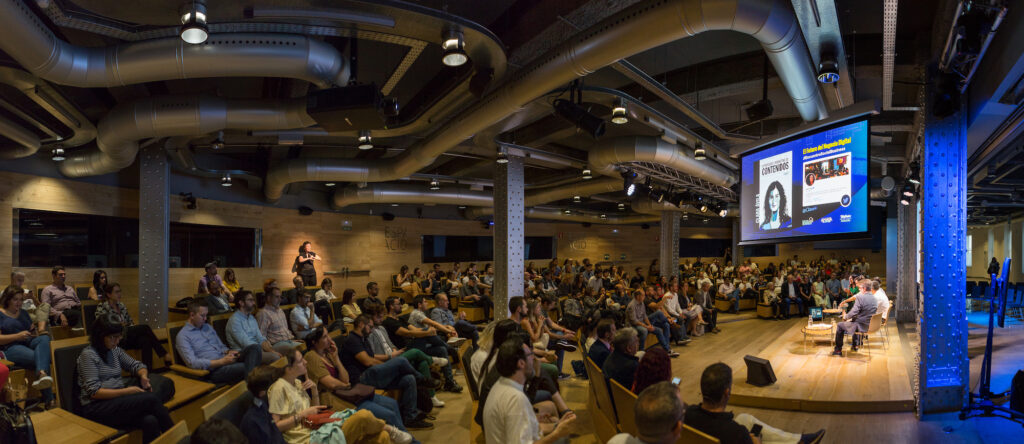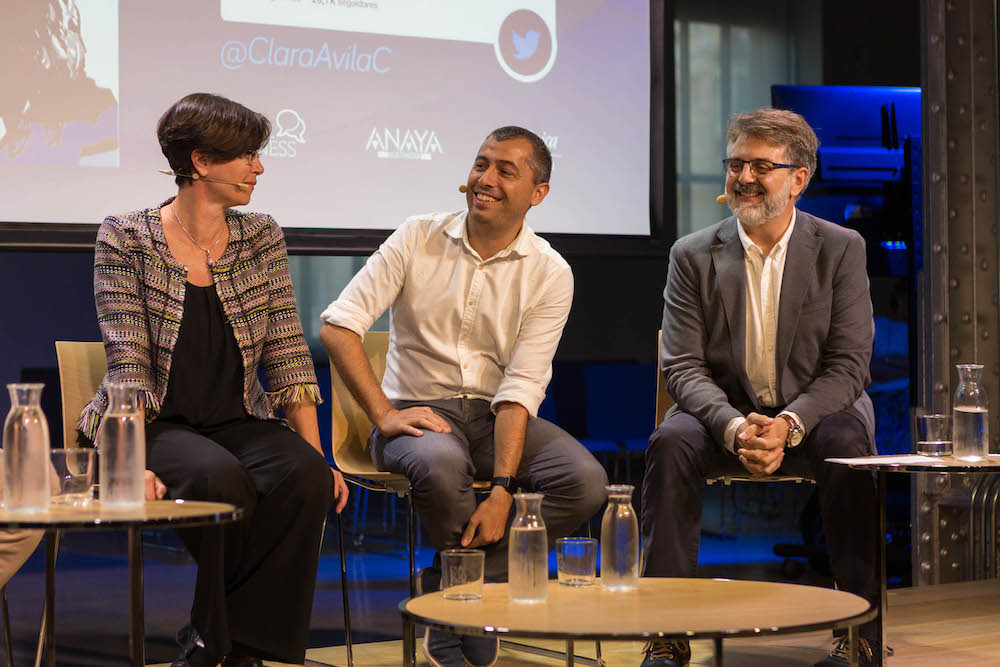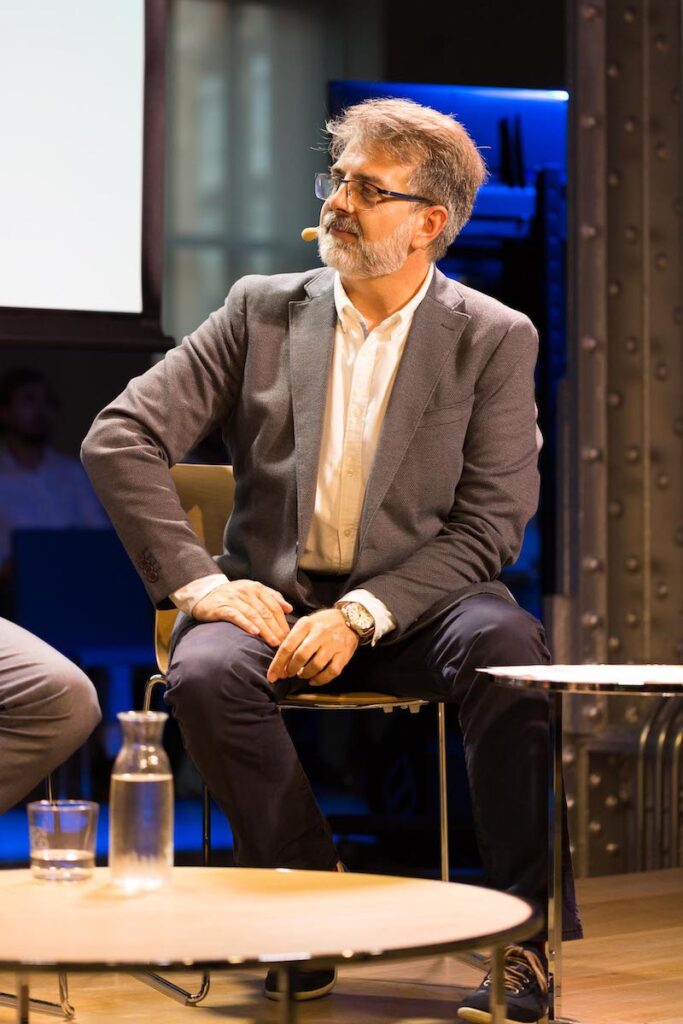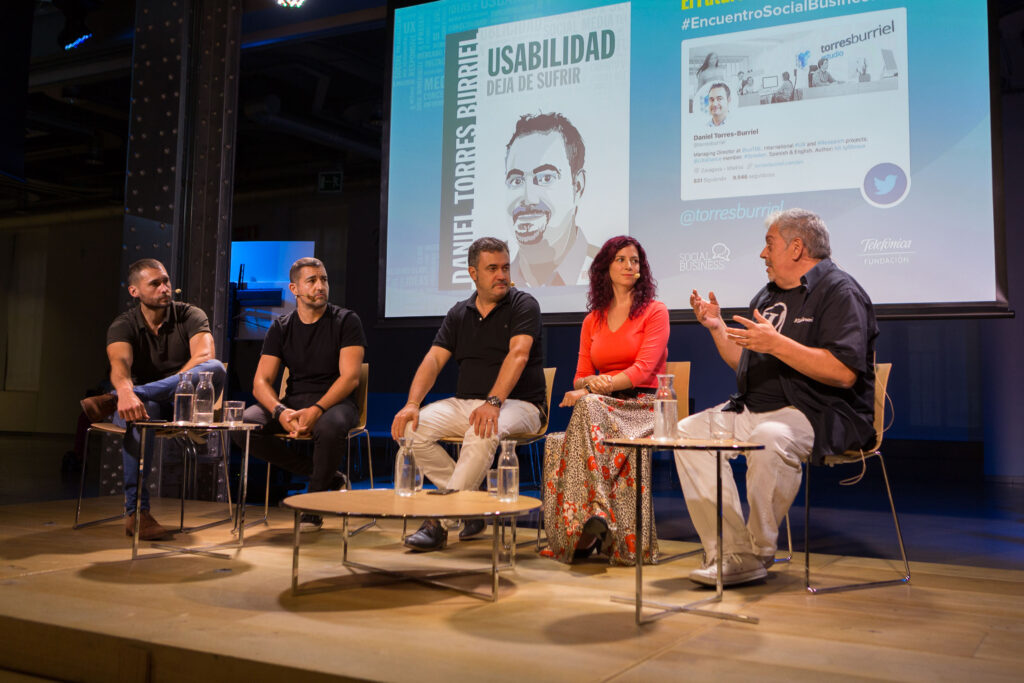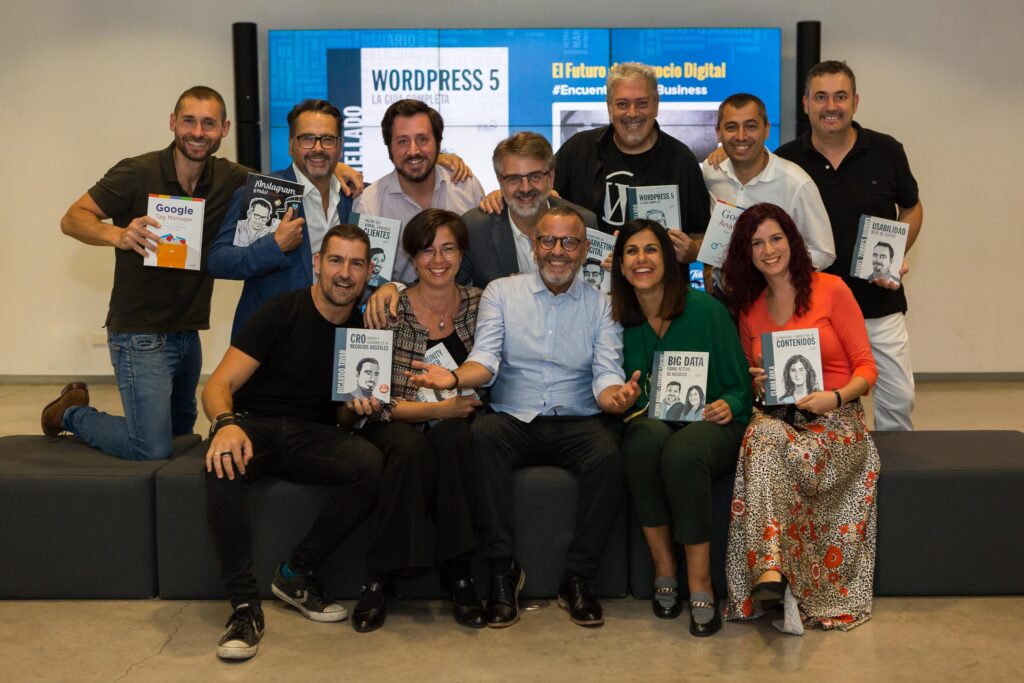Written by Aurora Maciá
Index
On September 26 took place the #EncuentroSocialBusiness organized by the publishing house Anaya Multimedia at the Espacio Fundación Telefónica, which hung the sold out sign days before the event. The publishing house brought together the leading authors in digital marketing and communication in Spain to discuss the future of digital business. As we told you in last Tuesday’s post, this event was structured in two round tables:
- Trends in digital marketing and communication, moderated by Fernando Maciá, with the participation of Asier Barainka, María Lázaro, Gemma Muñoz and Tristán Elósegui.
- Digital product design and development, moderated by Iñaki Gorostiza, with Ricardo Tayar, Daniel Torres Burriel, Fernando Tellado and Clara Ávila.
The meeting was introduced by Phil González, who began by giving the floor to Eugenio Tuya, editor of the Social Business collection. Eugenio stressed the importance of the fact that Spanish authors have managed to carve out a niche for themselves in a sector dominated by Anglo-Saxon books.
Round table on digital marketing and communication trends
Do not divide and conquer
As we know, the world of digital marketing is very broad (SEO, Content, RRSS, etc.) and each of the authors present at the table was a specialist in one of its sectors. In this regard, Fernando asked them if they will be able to combine strategies to form the “digital revolution” together or if each one will “sweep for home”.
María Lázaro is very clear: “either the strategies are integrated, or it makes no sense at all”. We must use all the tools at our disposal to sell, whether it is SEO, data analysis, social networks, etc. Moreover, they are often interdependent on each other.
However, Asier Barainka acknowledged the difficulty that some companies might encounter in carrying out all strategies at the same time and believes that “if you can’t do something well, it is better to leave it aside”. Given a choice, he’s sticking with SEO and data analysis.
Tristán Elósegui pointed out that the first thing to do is to set out the business strategy at a global level and know which audience we are targeting, and from there, define the marketing plan, trying to include all possible tools.
Big Data
Fernando asked whether strategies such as Big Data, so fashionable nowadays, are accessible to any type of company.
Gemma confessed to being fed up with the popular use of the term “Big Data” as a synonym for data warehousing: data warehousing is useless if it does not impact the company’s bottom line. For Gemma, if you don’t act on that data, it’s not Big Data. The main thing is to know what each business needs, from there to store “with head” what is needed and use it to know if the strategies that are being implemented are working.
Maria agrees with her colleague’s words: “data in itself is worthless“, it must be used to make decisions and take action.
Better than sales, get customers
This is the title of the book by Tristán Elósegui, who explained that the obsession with sales is far removed from the principles of marketing, which dictate that the audience should be accompanied from the moment they first meet the brand until they become loyal. This is the only way to convince the person to buy our product and even to recommend us.
In this aspect, Fernando, author of “Digital Marketing Strategies” pointed out how certain strategies start to become too obvious and put too much pressure on the user to make the sale. Asier believes that “we are being a bit crude” and are not yet using tools such as retargeting in the best way, but he does not see the problem in using them. Tristán believes that it is necessary to go “for those who are a little higher up,” that is, to attract to the product those who are still far away from the purchase decision instead of pressuring those who are already practically clicking on the cart.
Social networks
Fernando asked Maria if we should also think about what our brand needs and what our objectives are before opening a profile on a social network. The author of “Community Manager. The definitive guide” confirmed that, indeed, the first thing to do is to close the computer and think about where the people we want to target are. María pointed out that “we do not sell through social networks,” but rather they will serve more to generate awareness and engagement, and therefore the first thing is to have our own channels to ensure sales. Social networks should never replace them.
How to use experience in new strategies?
Fernando commented on how some older entrepreneurs do not dare to lead this type of strategy and delegate to younger people who are more familiar with the digital environment but lack his extensive experience. How can you leverage their years of experience and how can you facilitate their entry into the world of online marketing?
Asier believes that we now have other tools to analyze data, but we are not doing anything new. The main thing is strategy, and here veteran entrepreneurs can contribute a lot. The tools have to be simply a support.
Training
What would you recommend to a person who is outside the academic environment but wants to train in digital marketing, where should they start,” Fernando asked.
Gemma believes that we can’t know everything, but if we are interested in a certain field we have plenty of information in the form of blogs, podcasts, masters, etc. However, he believes that by reading, we can design our own path and discover many fields at the same time.
Tristán said that the first thing to do is to have a global vision of everything that is available, to know a little about all the areas, and then we can specialize.
Asier pointed out that, if we don’t know where to start, the first thing would be to learn html. Learning the minimum technical basics can allow us to understand the basics of the digital world.
What is the best thing about publishing a book?
Gemma likes to know that there are people who are taking their first steps in the world of data analysis and digital marketing with her book, she admits that it is a responsibility but she feels a lot of gratitude.
Tristan remembered the reader who told him one day: “I read your book and I finally understood it”.
Maria imagines the person who can read her book as she writes, so when people send her photos with her book she makes a face at them: they are very different people, but they can all use her book.
Asier fondly remembered his mother’s 60-year-old neighbor who bought him the book just to have it on the shelf signed by him.
Fernando is happy to have opened professional paths as a result of his book since there are people who are now dedicated to SEO because they once read one of his books.
Round table on digital product design and development
What is a digital product?
Although Wikipedia defines it as “non-material good sold on an online platform”, Iñaki Gorostiza also considers as digital products the hotels we book online, the airline tickets we buy, even people can be digital products.
Ricardo Tayar pointed out that in the sector there is a tendency to rename things “to make them cooler”. For him, a digital product is no longer just the interface but all the technology that makes it possible to do something that satisfies a need: an app, a website, etc.
Clara Ávila believes that the digital product is more things than we imagine: any product that is used from a device can be considered a digital product.
Fernando Tellado, for his part, considers, like Wikipedia, that a digital product is neither material nor palpable and that people cannot be digital products. According to Fernando, the digital product is a support or a format that has given birth to a brain “that is neither analog nor digital, it is human”.
Customization
Ricardo explains how customization projects are becoming more and more numerous, but, in reality, full customization does not exist today, since they work with sets of users. The human factor is very relevant, we must understand that not all of us have the same motivations and preferences. If personalization is done well and ethically, our business will work and our customer will have a good experience. The important thing, Ricardo points out, “is the maturity of the companies at a conceptual level and at a digital level, and now things can be done”.
Fernando Tellado then expressed his concern about how our data is being managed, we do not know what it is being used for. Fernando believes that free software like WordPress is what companies should be aiming for, where nothing can be hidden.
Clara Ávila declared herself in favor of personalization: “the more we target their needs [del usuario], thebetter product we are going to design“. The content management that brands can do when they have information about the user is likely to bring more to the user than something they are not interested in. However, when we ask people if they want to give up some of their privacy in exchange for greater personalization, most refuse, said Daniel Torres.
Finally, all agreed on the need to take care of the personal side, ethics, and not to design products that deceive people and make them accept things they do not understand.
Three keys that determine the success of an online product sale
For Iñaki, technical implementation is very important, followed by data analysis and action in relation to this data.
Ricardo believes that the most important thing is for the product to be understood, to tell it well. Secondly, payment systems must be accessible and easy to use. Finally, it should be noted that the sales process does not end when the product is purchased, but there is a subsequent evaluation that is reflected in reviews on Amazon, TripAdvisor, etc.
Daniel Torres said that “ask, ask and ask” is the main thing. Later, he also stressed the need to be honest and not “cheat”. Lastly, we need to watch our biases.
For Clara, we have to make sure that the product we sell satisfies the person’s needs, that it does not generate a need but rather responds to it. It is equally important that the conversation is friendly and that the company is able to generate traffic consistent with what it is selling.
Fernando Tellado highlights the need not to cede our entire digital platform to proprietary companies, but to free and open software. Secondly, the sales process should occur in applications that are scalable and can be adapted to the size of our business. Finally, you need to think about all devices, not just the desktop version.
After the two round tables, the audience was able to chat with the speakers and take away their signed books.
Below you have the complete streaming of the event.
